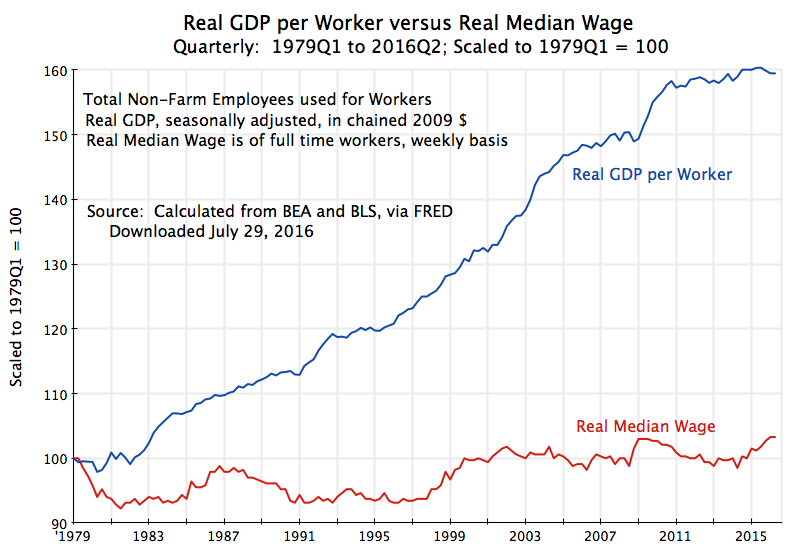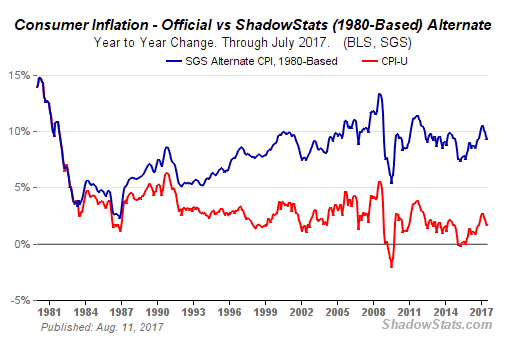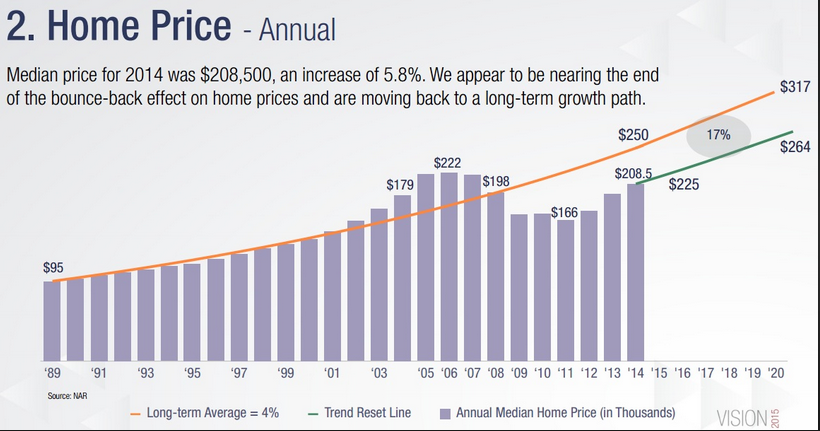
Facebook Post September 10, 2017
Bourgeois pundits are always looking at these productivity-vs-wages charts trying to figure out, “what’s wrong with U.S. labor? Why the disconnect between productivity & wages?” This is usually in the context of writing material for public consumption.
Perhaps we need to look at things a different way. Perhaps it is true, that in this “late-stage capitalism,” stagnant, even falling, wages for the proletariat and the worse-off precariat class, are a crucial feature of hyperproductivity. This “disconnect” is actually a full “connect,” baked-in to the system at this stage.
Why does the wage graph show “real wages” as fairly stable or flat-lined, when the lived experience of the lower half of our working class is actually of falling real wages? I believe this is because the Bureau of Labor Statistics incorrectly measures “cost of living” or inflation rate as experienced by working and poor people. Why they would do this is easily understood. a) prevents people on Social Security from getting cost-of-living benefit increases; b) reassures the stock market’s equity owners that everything is cool; c) keeps other measures that are tied to “inflation” stable too, such as the Federal Reserve’s interest-rate fix every month. Think about it. See if you don’t come to similar conclusions.
Changing political policy to try and “fix” the “disconnect” isn’t going to be very probable to succeed, because the forces are all acting in the direction of further hyperproductivity. With robotics and machine-learning systems only in their very early stages, there’s a lot more “disconnect” to come.

There has been some criticism of my use of this Shadow Government Statistic site, and there are searchabe “debunking” articles posted around that take aim at SGS. Some even call it a “cult” (!) I take these criticisms seriously, in this era of “fake news,” because we don’t want to be citing data that might be spurious or just downright false.
Here’s what the SGS site says with respect to their method–
“In the charts to the right we show two SGS-Alternate CPI estimates: One based on the pre-1990 official methodology for computing the CPI-U, and the other based on the methodology which was employed prior to 1980.
Please note: Our Data Download is currently only providing the 1980-Based numbers, but 1990-Based numbers will be introduced shortly.”
Whoever may have the correct methodology, we must address the *lived experience* of our working class and that includes our not-working class. Why do so many of our friends, all over the nation, report that the rent is killing them, and they’re not sure they’ll be able to keep their place, and might have to go living out of their car?
Return of the “Housing Bubble?”
Here’s a chart that seems fairly typical on chart-searches dealing with home prices–from a site catering to real-estate agents. In some housing market areas, if you can believe the NPR gung-ho-corporate show “Marketplace,” in some markets in the U.S.A., house prices have already surpassed those in the “housing bubble.” As these house prices rise, so goes the rent for working-class and poor folks in the communities with fast-rising prices. It’s why, nationwide, “That rent is too damn high!”
The reason the high-end determines the rent for the low-end is, almost NOTHING is being built for us low-ended folks. The corporate state has no intention of meeting the human needs for housing in this nation. Housing policy in the nation is geared around only one end, and that is, turning a profit for those corporations which supply this market.

Perma-Recession for Our Working Class?
So, in working with the big econometrics models just lately, here’s what I’m coming up with.
There’s been a “perma-recession” in working-class living standards since 1990. This is derived from using old-school cost-of-living methodology (from 1990), which consistently shows baseline “inflation” at 3.5% or more above the BLS reported official “inflation.” So, worker real wages have not been stagnating (hovering around 0% increase, with occasional plus and minus ticks).
No, worker real wages have been declining steadily around 3.5% per annum since 1990.
The mysterious “disconnect” between astounding productivity-per-worker (GDP per worker) and falling real wages is NOT a disconnect. It is a built-in, baked-in feature in current capitalism.
You cannot allow politicians to deceive you on this. For example, I believe the whole Clinton-Gore era was acceptable to the U.S. ruling class because it was opening up the “Chinafication” of the U.S. working class. First, dismantling heavy industry in the 1980s. Then, runaway companies in the 80s-mid 90s. Then, “outsourcing” to China. And finally, fully integrating China (including robotics such as Foxconn introduces) into the global economy so as to completely debilitate and wipe-out U.S. working-class economic, and then political, power.
We’re been in perma-recession for nearly three decades, folks. Judge your politicians by their degree of honesty about the real situation, the lived poverty and stress, or our working-poor population. If revolutionaries are to be taken seriously by the class, we must be speaking and writing accurately about the conditions people in the local communities are living under—neither engage in hyperbole nor in trying to offer false hopes that cannot be realized.
The danger from the unified Trump – Republican camp is that they speak of the deteriorated conditions of our working class, even painting a “horrible” picture of what has happened via de-industrialization, offshoring and outsourcing, the “Chinafication of labor,” and the full integration of low-wage nations into the global economy. This resonates with people, who know what is what in their own lives, and don’t see anything getting better. The Trumpists then turn this resonance back against the working class, using fear of “the other”–immigrants from Mexico, Central America, Muslim nations, or black workers, to divide our class and make us politically powerless.
The danger from the Democratic Party is that the leadership offers to “reform capitalism,” to make it more “justice capitalism,” or “non-crony capitalism, a fair shake for all,” or “green capitalism, sustainable capitalism,” or any other hyphenated capitalism. The appeal is to return to an imagined better-days, a bygone era that can be re-created and can offer the return of a standard of living that began to vanish in the early days of the Reagan Era.
Our working class have to find a way forward independent of these bourgeois narratives that offer fear and distrust of people living across the color line from us or who came from a different country, or with false hope that cannot be realized because it is not grounded in the real facts on the ground.
We would welcome other statistics from other methodology that help shed light on the real-wages vs. productivity questions we raise in this piece. It’s crucial to get this story right.
Signed articles are the responsibility of the author.
Bobby G is a retired industrial worker who belonged to the IAM, the IUE, and finally, the UE. He now serves in local government in Wisconsin. Bobby says, “No question, the League of Revolutionary Black Workers and the successors to the organization were the biggest influence on my politics during my whole working life, and even now.”